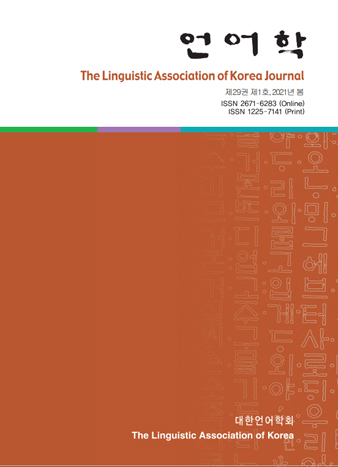대한언어학회 전자저널

29권 1호 (2021년 3월)
- 코로나 19로 인한 비대면 온라인 강의 인식 조사: 대학생의 만족도와 불안도를 중심으로
-
황요한 · 김창수
Pages : 71-91
Abstract
Hwang, Yohan & Kim, Changsoo. (2021). Perceptions toward non-face-to-face online class operations during the COVID-19 pandemic: Focusing on university students satisfaction and anxiety. The Linguistic Association of Korea Journal, 29(1), 71-91. The outbreak of the coronavirus has dramatically changed the way people live and inevitably transformed the practice of social distancing which has changed the forms and methods of education. The main purpose of this study is to examine the application and operation of non-face-to-face online classes in a university setting during COVID-19. In order to achieve this goal, this paper conducts an in-depth analysis of 255 university students perceptions toward satisfaction and anxiety over online learning and new circumstances surrounding online education. The results and suggestions are as follows. The main factors that have a positive influence on students' satisfaction in an online classroom environment come from the easy access to course content and opportunities for review and the possibility of self-directed learning beyond time and space limitations. Second, in order to increase its effectiveness, both internal efforts to improve the quality of course contents and external support for student and class management have to be (re)considered. Based on the findings from crisis to opportunity, this study suggests the need for careful planning and implementation of new procedures and guidelines for inclusive and resilient online education systems in the aftermath of COVID-19.
Keywords
# 코로나 19(COVID-19) # 비대면 수업(non-face-to-face class) # 온라인 학습(online learning) # 대학교육(university education) # 만족도와 불안도(satisfaction and anxiety)
References
- 김미은, 김민정, 오예인, 정수연. (2020). 코로나 19(COVID-19)로 인한 온라인 강의 대체가 간호대학생의 학습동기, 교수와 학생의 상호작용 및 온라인 수업만족도에 미치는 영향. 학습자중심교과교육연구, 20(17), 519-541.
- 김미형. (2020). 코로나19로 인한 대학 글쓰기 강좌의 원격화상수업화에 따른 문제점과 대응책-2020학년도 1학기 홍익대 <논리적 사고와 글쓰기> 강좌의 사례를 중심으로. 인문과학, 120, 5-49.
- 김보영, 한승우. (2020). 코로나19로 인한 비자발적 ‘대학 온라인 강의’에 대한 만족도 연구. 교양학연구, 13, 7-31.
- 김은혜, 이정미. (2020). 코로나19로 인한 비대면 원격수업의 학습참여활동에 따른 학업성취도 차이분석: A대학교 Smart Class를 중심으로. 상업교육연구, 34(6), 1-21.
- 노성동. (2020). 코로나 19사태로 인한 대학생들의 심리적 영향과 극복요인. 신학과 실천, 72, 331-356.
- 도재우. (2020). 면대면 수업의 온라인 수업 전환과정에서 발생하는 설계 장애물에 대한 탐색. 교육문화연구, 26(2), 153-173.
- 마승혜, 허정경. (2020). 코로나19 상황에서 온라인 원격수업 질적 향상을 위한 학습자 인식 조사-통번역 과목 수강 학부생 설문 조사를 중심으로. 번역학연구, 21(4), 39-61.
- 박은경. (2020). 코로나19 확산에 따른 온라인 교양영어 수업에서 학생들이 느끼는 불안감에 대한 인식조사. 멀티미디어언어교육, 23(3), 320-338.
- 송수연, 김한경. (2020). 언택트 시대의 대학교육: 코로나19에 따른 비대면 강의 만족도와 수강지속 의사에 영향을 미치는 요인에 관한 연구. 아시아교육연구, 21(4), 1099-1126.
- 이동주, 김민숙. (2020). 코로나19 상황에서의 대학 온라인 원격교육 실태와 개선 방안. 멀티미디어언어교육, 23(3), 359-377.
- 장원형, 최민지. (2020). 코로나바이러스감염증-19 대유행에 따른 대학교 비대면 실험수업 운영에 관한 사례연구. 학습자중심교과교육연구, 20(17), 937-966.
- 정봉영. (2002). 사이버대학 학습자들의 인구학적 특성에 따른 학업성취도와 수업만족도 분석 - S대학교 사례를 중심으로. 학습자중심교과교육연구, 10(3), 127-150.
- 정주영. (2020). 포스트 코로나 시대의 대학교육 질 제고 방안 연구. 미래교육학연구, 33(3), 171-192.
- 정향기. (2020). 코로나19 상황의 대학교육에 있어서 전면적 온라인 수업 실행 및 평가에 대한 학습자 만족도. 멀티미디어언어교육, 23(3). 392-412.
- 조수선, 주라헬. (2020). 전면적 원격수업 상황에서 대학생의 학습몰입에 영향을 미치는 요인 연구: 코로나 불안의 조절효과. 교육정보미디어연구, 26(4), 909-934.
- 최원경. (2020). 면대면 대 비대면 강의 만족도 비교: 코로나19 사태에서의 대학원 교양영어 수업 사례 연구. 영어교과교육, 19(4), 223-245.
- 황규호. (2020). 포스트 코로나 시대 국가교육과정의 과제. 교육과정연구, 38(4), 83-106.
- Gardner, R. C. (1985). Social psychology and second language learning: The role of attitudes and motivation. London: Edward Arnold.
- Rosenberg, M. J. (2001). E-Learning strategies for delivering knowledge in the digital age. New York, NY: McGraw-Hill Companies, Inc.